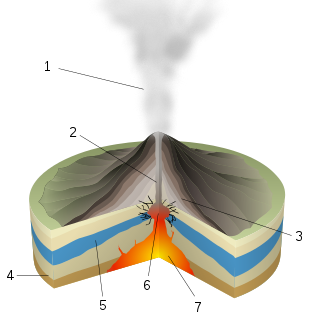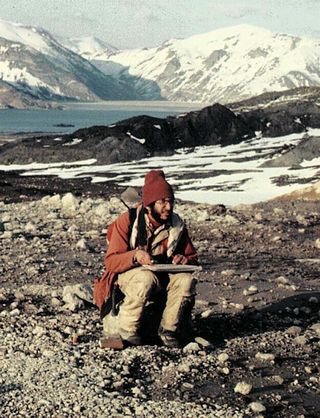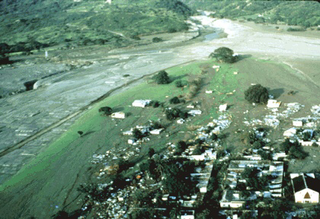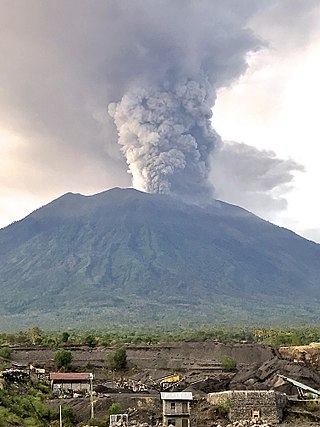
The Galeras tragedy occurred when six scientists and three tourists were killed as a result of the January 1993 eruption of the Galeras stratovolcano in Colombia. Geologist Stanley Williams and six others on the volcano survived.

The Galeras tragedy occurred when six scientists and three tourists were killed as a result of the January 1993 eruption of the Galeras stratovolcano in Colombia. Geologist Stanley Williams and six others on the volcano survived.
The scientists were at Galeras to collect monitoring data about its levels of activity—including collecting some of the gases, and looking for tiny changes in the gravity field. They were attending a conference in Pasto organized by the United Nations to gather geologists to study Galeras in order to assess its potential threat to nearby population. Past research had determined that Galeras would probably erupt again in the future, possibly endangering Pasto's population of approximately 300,000 people and another 400,000 living in the vicinity of the volcano. [1] Shortly after 1 pm on 14 January 1993, there was an explosion in the summit crater without warning. At that time, there were about 12 people in or around the crater. Nine people were killed outright in the explosions. Six were volcanologists: Geoff Brown, from the U.K.; Igor Menyailov, a Russian; and Fernando Cuenco, Carlos Trujillo, Nestor Garcia and José Arlés Zapata from Colombia. [2] Other volcanologists who had been involved in the same conference, and were on other parts of the volcano at the time, saw the explosion from a distance and became involved in the rescue. Among those who helped to rescue the workshop leader, Stan Williams, and the other casualties were Marta Calvache, then director of the Galeras Volcano Observatory in Pasto; and Patty Mothes, an American volcanologist based at IG-EPN, Quito. [3]


At the time of the eruption, most predictions were made similarly to the one before the 1980 eruption of Mount St. Helens — that a volcano would erupt, but not specifying an exact time. C. Dan Miller of the United States Geological Survey remarked: [4]
We're able to do a much better job of monitoring the changes that occur at volcanoes as they wake up, but we are still quite a long ways from being able to forecast the time, the magnitude and the character of an eruption.
Since the disaster, research has improved scientists' ability to predict volcanic eruptions. Still, there is not a definite method of prediction. Though scientists were able to make accurate analysis by employing long-period earthquakes, short bursts of seismic energy, to forecast the 1990 eruption of Mount Redoubt in Alaska, these events are known also to occur at volcanoes that do not erupt. In early October 2004, for example, long-period events took place at Mount St. Helens, only to precede insignificant events. [4] One lasting and tangible outcome of the tragedy was a set of recommendations concerning safety equipment and clothing that should be used when working on active volcanoes, for example, hard hats and fire-proof coveralls. [5]

A volcano is a rupture in the crust of a planetary-mass object, such as Earth, that allows hot lava, volcanic ash, and gases to escape from a magma chamber below the surface. The process that forms volcanoes is called volcanism.

Mount St. Helens is an active stratovolcano located in Skamania County, Washington, in the Pacific Northwest region of the United States. It lies 52 miles (83 km) northeast of Portland, Oregon, and 98 miles (158 km) south of Seattle. Mount St. Helens takes its English name from that of the British diplomat Alleyne Fitzherbert, 1st Baron St Helens, a friend of explorer George Vancouver who surveyed the area in the late 18th century. The volcano is part of the Cascade Volcanic Arc, a segment of the Pacific Ring of Fire.

The Ring of Fire is a tectonic belt of volcanoes and earthquakes.

Volcanology is the study of volcanoes, lava, magma and related geological, geophysical and geochemical phenomena (volcanism). The term volcanology is derived from the Latin word vulcan. Vulcan was the ancient Roman god of fire.

A volcanologist, or volcano scientist, is a geologist who focuses on understanding the formation and eruptive activity of volcanoes. Volcanologists frequently visit volcanoes, sometimes active ones, to observe and monitor volcanic eruptions, collect eruptive products including tephra, rock and lava samples. One major focus of inquiry in recent times is the prediction of eruptions to alleviate the impact on surrounding populations and monitor natural hazards associated with volcanic activity. Geologists who research volcanic materials that make up the solid Earth are referred to as igneous petrologists.

Nevado del Ruiz, also known as La Mesa de Herveo is a volcano on the border of the departments of Caldas and Tolima in Colombia, being the highest point of both. It is located about 130 km (81 mi) west of the capital city Bogotá. It is a stratovolcano composed of many layers of lava alternating with hardened volcanic ash and other pyroclastic rocks. Volcanic activity at Nevado del Ruiz began about two million years ago, during the Early Pleistocene or Late Pliocene, with three major eruptive periods. The current volcanic cone formed during the present eruptive period, which began 150,000 years ago.

Dante's Peak is a 1997 American disaster film directed by Roger Donaldson, written by Leslie Bohem, and starring Pierce Brosnan, Linda Hamilton, and Charles Hallahan. The film is set in the fictional town of Dante's Peak where the inhabitants fight to survive a volcanic eruption from a long dormant stratovolcano that has suddenly woken up. The film was released on February 7, 1997, under the production of Universal Pictures and Pacific Western Productions. It received mixed reviews from critics but was an average success financially. It was the last film in which Charles Hallahan starred before his death nine months later in November 1997.

On March 27, 1980, a series of volcanic explosions and pyroclastic flows began at Mount St. Helens in Skamania County, Washington, United States. A series of phreatic blasts occurred from the summit and escalated until a major explosive eruption took place on May 18, 1980, at 8:32 am. The eruption, which had a volcanic explosivity index of 5, was the first to occur in the contiguous United States since the much smaller 1915 eruption of Lassen Peak in California. It has often been declared the most disastrous volcanic eruption in U.S. history.

A phreatic eruption, also called a phreatic explosion, ultravulcanian eruption or steam-blast eruption, occurs when magma heats ground water or surface water. The extreme temperature of the magma causes near-instantaneous evaporation of water to steam, resulting in an explosion of steam, water, ash, rock, and volcanic bombs. At Mount St. Helens in Washington state, hundreds of steam explosions preceded the 1980 Plinian eruption of the volcano. A less intense geothermal event may result in a mud volcano.

David Alexander Johnston was an American United States Geological Survey (USGS) volcanologist who was killed by the 1980 eruption of Mount St. Helens in the U.S. state of Washington. A principal scientist on the USGS monitoring team, Johnston was killed in the eruption while manning an observation post six miles (10 km) away on the morning of May 18, 1980. He was the first to report the eruption, transmitting "Vancouver! Vancouver! This is it!" before he was swept away by a lateral blast; despite a thorough search, Johnston's body was never found, but state highway workers discovered remnants of his USGS trailer in 1993.

Harry Glicken was an American volcanologist. He researched Mount St. Helens in the United States before and after its 1980 eruption, and was very distraught about the death of volcanologist David A. Johnston, who was Glicken's mentor and supervisor in Spring 1980 at Mount St. Helens. Glicken was initially assigned to the USGS observation post in the weeks leading up to the eruption but was called away the night before the eruption.

Redoubt Volcano, or Mount Redoubt, is an active stratovolcano in the largely volcanic Aleutian Range of the U.S. state of Alaska. Located at the head of the Chigmit Mountains subrange in Lake Clark National Park and Preserve, the mountain is just west of Cook Inlet, in the Kenai Peninsula Borough about 110 miles (180 km) southwest of Anchorage. At 10,197 feet (3,108 m), in just over 5 miles (8.0 km) Mount Redoubt attains 9,150 feet (2,790 m) of prominence over its surrounding terrain. It is the highest summit in the Aleutian Range. In 1976, Redoubt Volcano was designated as a National Natural Landmark by the National Park Service.

Galeras is an Andean stratovolcano in the Colombian department of Nariño, near the departmental capital Pasto. Its summit rises 4,276 metres (14,029 ft) above sea level. It has erupted frequently since the Spanish conquest, with its first historical eruption being recorded on December 7, 1580. A 1993 eruption killed nine people, including six scientists who had descended into the volcano's crater to sample gases and take gravity measurements in an attempt to be able to predict future eruptions. It is currently the most active volcano in Colombia.
The Decade Volcanoes are 16 volcanoes identified by the International Association of Volcanology and Chemistry of the Earth's Interior (IAVCEI) as being worthy of particular study in light of their history of large, destructive eruptions and proximity to densely populated areas. The Decade Volcanoes project encourages studies and public-awareness activities at these volcanoes, with the aim of achieving a better understanding of the volcanoes and the dangers they present, and thus being able to reduce the severity of natural disasters.

The Armero tragedy occurred following the eruption of the Nevado del Ruiz stratovolcano in Tolima, Colombia, on November 13, 1985. The volcano's eruption after 69 years of dormancy caught nearby towns unprepared, even though volcanological organizations had warned the government to evacuate the area after they detected volcanic activity two months earlier.

Prediction of volcanic activity, and volcanic eruption forecasting, is an interdisciplinary monitoring and research effort to predict the time and severity of a volcano's eruption. Of particular importance is the prediction of hazardous eruptions that could lead to catastrophic loss of life, property, and disruption of human activities.

Several types of volcanic eruptions—during which material is expelled from a volcanic vent or fissure—have been distinguished by volcanologists. These are often named after famous volcanoes where that type of behavior has been observed. Some volcanoes may exhibit only one characteristic type of eruption during a period of activity, while others may display an entire sequence of types all in one eruptive series.

Barry Voight is an American geologist, volcanologist, author, and engineer. After earning his Ph.D. at Columbia University, Voight worked as a professor of geology at several universities, including Pennsylvania State University, where he taught from 1964 until his retirement in 2005. He remains an emeritus professor there and still conducts research, focusing on rock mechanics, plate tectonics, disaster prevention, and geotechnical engineering.

Mount Agung, a volcano on the island of Bali in Indonesia, erupted five times in late November 2017, causing thousands to evacuate, disrupting air travel and causing environmental damage. As of 27 November 2017, the alert level was at its highest and evacuation orders were in place.
Marta Lucía Calvache Velasco is a Colombian geologist and volcanologist, best known for her work on geological hazards and risk reduction in Colombia.